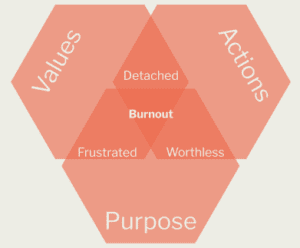
The Illusion of Resilience in Toxic Work Cultures: An Analysis of Burnout
In the modern workplace, burnout has become an alarming epidemic. Surveys like Gallup’s research suggests that 76 percent of employees experience burnout on the job at least sometimes and 28 percent say they are burned out “very often” or “always” at work. This is not sustainable. Resilience training, hailed as a tool to manage workplace stress, is increasingly embraced. However, does it provide a holistic solution, especially when workplace toxicity is the primary factor?
Burnout: The Silent Crisis
The insidious nature of burnout isn’t just about personal mental health. The associated risks extend to substance abuse, depression, and even suicide. The impact on organisations is tangible, with repercussions such as lowered productivity, increased absenteeism, and high turnover rates. The ensuing cost on industries is colossal, with billions lost annually.
The Psychological Impact of Burnout
Burnout is more than just exhaustion or disengagement from work. It has profound psychological consequences that can ripple through an individual’s entire life.
- Emotional Exhaustion: At the core of burnout is emotional exhaustion. This is characterised by feeling drained, fatigued, and unable to cope. Over time, this emotional depletion makes it difficult for employees to muster the energy to face daily challenges, leading to decreased motivation and enthusiasm for tasks they once enjoyed.
- Increased Anxiety: As burnout progresses, it’s not uncommon for individuals to experience heightened anxiety levels. The constant stress and pressure can cause persistent feelings of tension and worry, even when not at work. This can interfere with an individual’s ability to relax or detach from their job during off-hours.
- Deep-seated Cynicism: One of the hallmark symptoms of burnout is an increasing detachment and cynicism towards one’s job and colleagues. Employees may begin to distance themselves from coworkers, view tasks with disdain, and become sceptical of organisational goals or changes.
- Reduced Professional Efficacy: Over time, the cumulative effects of burnout can lead to decreased confidence in one’s professional abilities. Tasks that were once easy may seem insurmountable, and the individual might doubt their capability to perform well, leading to a decline in overall job performance.
- Physical Manifestations: The mind-body connection means that psychological stress often manifests in physical symptoms. Employees suffering from burnout might experience headaches, digestive issues, sleep disturbances, and even chronic conditions like hypertension.
- Impaired Decision Making and Cognitive Function: Chronic stress and burnout can impact cognitive functions. Decision-making becomes more challenging, attention spans shorten, and there might be difficulties in problem-solving or critical thinking.
In the face of such profound impacts, it becomes clear that burnout isn’t merely a personal issue or a temporary phase. It’s a significant mental health concern that demands attention from both individuals and organisations.
Root Causes of Burnout
Understanding the root causes of burnout is paramount for organisations aiming to tackle this growing epidemic. Each factor plays a significant role in influencing employees’ mental and emotional well-being:
- Overwhelming Workload:
- Depth: Employees regularly faced with back-to-back tasks, constant overtime, and mounting pressures often find little room to breathe. As the load persists without break, it becomes not just a physical strain but a mental one too.
- Lack of Resources: Not having the necessary tools, support, or training to manage the workload can amplify the feeling of being overwhelmed.
- Loss of Autonomy:
- Micromanagement: Constant oversight and minimal trust in an employee’s decision-making abilities can lead to feelings of restriction and frustration.
- Limited Growth Opportunities: Without the chance to make independent decisions or take on leadership roles, employees can feel stagnant and underappreciated.
- Blurred Work-Life Boundaries:
- Always-On Culture: With the rise of remote work and digital communication tools, many employees find it challenging to “switch off.” This perpetual connectivity means work-related stressors invade personal time.
- Personal Sacrifices: Missing out on family events, personal hobbies, or simply rest can lead to resentment towards the job.
- Lack of Recognition:
- Invisible Efforts: When hard work goes unnoticed or unappreciated, it can be demoralising for employees, leading them to question their value in the organisation.
- Absence of Feedback: Without constructive feedback, employees may feel they’re operating in a vacuum, unsure of how their contributions align with organisational goals.
- Ambiguity and Uncertainty:
- Shifting Goals: When objectives frequently change without clear communication, employees can feel disoriented, unsure of what’s expected of them.
- Job Insecurity: In unstable industries or companies undergoing restructuring, the constant threat of layoffs can be a significant source of stress.
- Toxic Behaviours:
- Permissive Environment: In some workplaces, toxic behaviours like bullying or discrimination persist because there’s a lack of accountability or repercussions for offenders.
- Silent Suffering: Employees might fear retaliation and, therefore, avoid reporting these behaviours, allowing them to continue unchecked.
By pinpointing these causes, organisations can create targeted interventions to reduce the risk of burnout and foster healthier work environments.
Resilience Training: A Double-Edged Sword
While resilience training programs offer coping mechanisms to handle stress, they often misdirect by focusing on individual-level solutions. This inadvertently places the onus on the employee to navigate a potentially toxic culture. The assumption that resilience alone can counter the negative impact of an adverse working environment is flawed.
Research by McKinsey Health Institute underlines the stark reality of this approach. Interventions aimed at individuals might offer temporary relief but seldom tackle the systemic issues fostering a toxic culture. Interestingly, fostering resilience might actually drive employees away, especially if they continuously face toxic behaviour.
Redefining Norms to Counter Toxicity
Addressing toxicity in the workplace requires a multifaceted approach, aimed not just at alleviating symptoms but also at transforming the root causes:
- Talent Management:
- Recruitment: Adopting a values-based recruitment approach ensures that new hires align with the company’s culture and ethics. This reduces the likelihood of introducing toxicity into the system.
- Engagement: Continuously engaging with employees through workshops, feedback sessions, and team-building exercises can help identify pockets of dissatisfaction and address them proactively.
- Rewards & Recognition: A fair and transparent rewards system can boost morale. Recognising not just performance but also values-driven behaviours can deter toxic practices.
- Development: Investing in employees’ growth, through training and mentorship, can create a sense of value and belonging, counteracting feelings of alienation or neglect.
- Leadership Development:
- Role Modelling: Leaders set the tone for behaviour in an organisation. Training leaders to exhibit the values and behaviours the company stands for is crucial.
- Open Communication: Encouraging leaders to maintain open channels of communication can create a safe environment for employees to voice concerns without fear of retaliation.
- Emotional Intelligence: Leaders with high emotional intelligence can better navigate conflicts, understand team dynamics, and foster a positive environment.
- Feedback Mechanisms:
- Regular Monitoring: Using tools like employee satisfaction surveys or pulse checks can provide real-time insights into team morale and potential problem areas.
- Performance Reviews: Transforming these from mere evaluations into constructive feedback sessions can help identify areas of improvement for both employees and management.
- Exit Interviews: Employees leaving the organisation can offer candid feedback about their experiences, providing invaluable insights into areas the organisation might need to address.
- Policy Revisions:
- Clear Boundaries: Policies that clearly demarcate work hours and encourage work-life balance can counter burnout.
- Anti-discrimination & Harassment: Strong policies against workplace bullying, harassment, and discrimination, backed by training and awareness campaigns, can deter toxic behaviours.
- Grievance Redressal: An effective grievance mechanism, ensuring anonymity and prompt action, can create trust and deter negative behaviours.
In essence, for businesses to thrive and genuinely foster a supportive environment, it’s essential not just to address symptoms but also to transform the root systemic causes that give rise to toxicity in the first place.
Conclusion: Creating a Holistic Framework for a Healthier Workplace
The modern corporate landscape, marked by rapid change and intense competition, often inadvertently nurtures toxicity. To navigate this, organisations cannot rely solely on isolated interventions like resilience training. Instead, a holistic approach is imperative:
- Understanding the Bigger Picture:
- Holistic Analysis: Beyond immediate concerns, it’s essential to understand deeper organisational dynamics, values misalignments, and systemic issues causing burnout and toxicity.
- Benchmarking: Organisations can utilise industry benchmarks to gauge where they stand in terms of employee well-being and workplace culture.
- Cultivating a Proactive Culture:
- Preventive Measures: Instead of waiting for issues to escalate, proactive measures, such as stress management workshops, team-building activities, and mental health awareness sessions, can be implemented.
- Celebrating Positivity: Publicly recognising and rewarding positive behaviours and values-driven achievements can shift focus from mere performance to holistic well-being.
- Engaging External Experts:
- Consultations: Engaging with organisational psychologists or workplace culture consultants can provide fresh perspectives and solutions tailored to specific challenges.
- Training Programs: Customised training modules, focusing on positive communication, conflict resolution, and empathy, can foster a healthier work environment.
- Investment in Technology:
- Digital Tools: Leveraging digital tools and platforms can help in monitoring employee well-being, collecting feedback, and implementing interventions.
- Data Analytics: Analysing patterns from collected data can predict potential burnout cases, allowing for timely intervention.
- Continuous Evolution:
- Feedback Loop: Constantly refining strategies based on feedback ensures that the approach remains relevant and effective.
- Staying Updated: Organisations must stay abreast of the latest research, tools, and strategies in workplace well-being to adapt and evolve.
In conclusion, a supportive and positive work environment is not a luxury but a necessity for the modern workplace. By focusing on comprehensive strategies that address both individual needs and systemic challenges, organisations can foster a culture that truly benefits employees and, by extension, the broader business ecosystem.
For an in-depth exploration of workplace well-being, burnout prevention strategies, and building resilient teams, we invite you to download our comprehensive resource guide. Dive deeper into solutions and gain actionable insights to foster a healthier organisational culture.
Download Clear Waters Guide Now













































